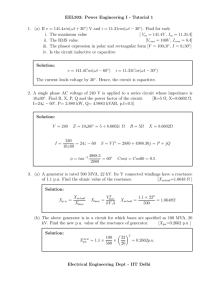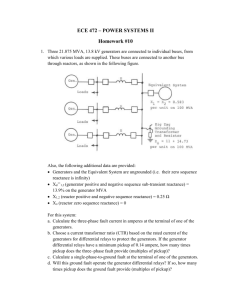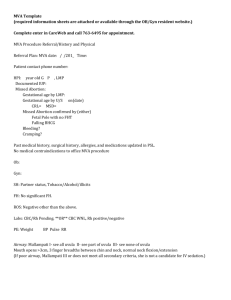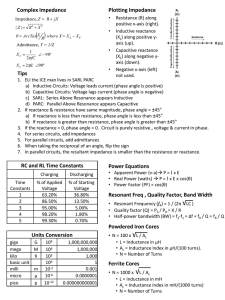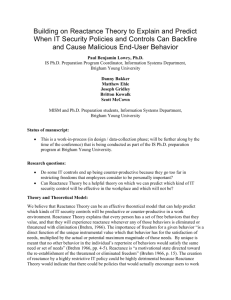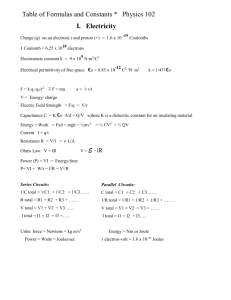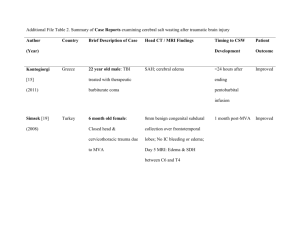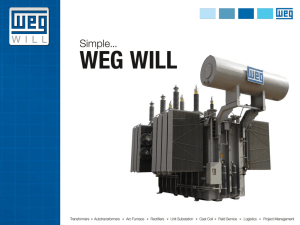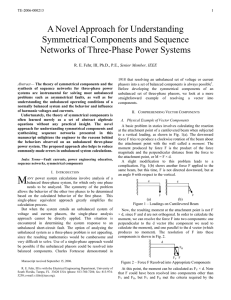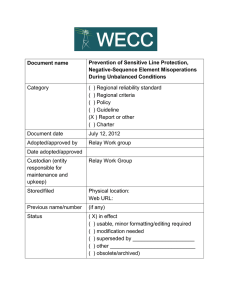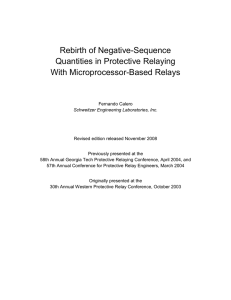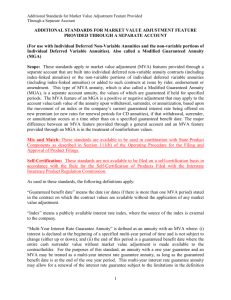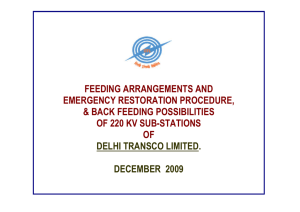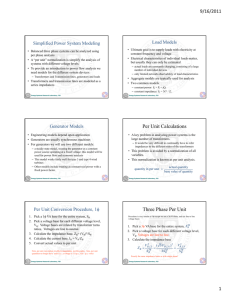Power System Analysis (solution) CT-1 Section-A
advertisement
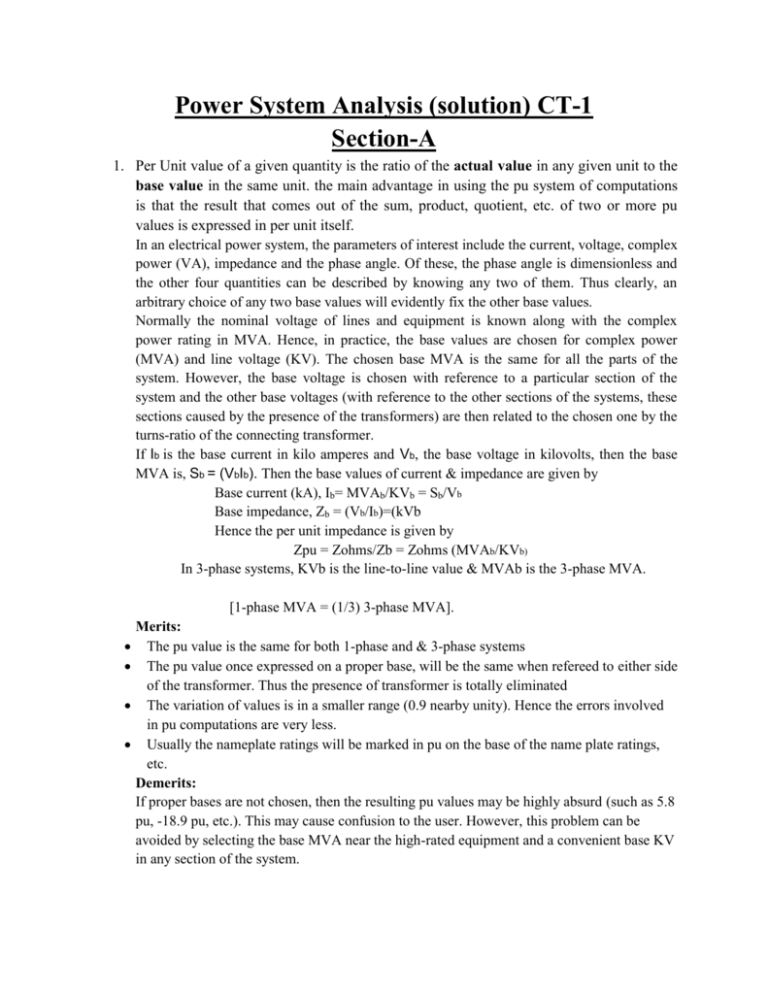
Power System Analysis (solution) CT-1 Section-A 1. Per Unit value of a given quantity is the ratio of the actual value in any given unit to the base value in the same unit. the main advantage in using the pu system of computations is that the result that comes out of the sum, product, quotient, etc. of two or more pu values is expressed in per unit itself. In an electrical power system, the parameters of interest include the current, voltage, complex power (VA), impedance and the phase angle. Of these, the phase angle is dimensionless and the other four quantities can be described by knowing any two of them. Thus clearly, an arbitrary choice of any two base values will evidently fix the other base values. Normally the nominal voltage of lines and equipment is known along with the complex power rating in MVA. Hence, in practice, the base values are chosen for complex power (MVA) and line voltage (KV). The chosen base MVA is the same for all the parts of the system. However, the base voltage is chosen with reference to a particular section of the system and the other base voltages (with reference to the other sections of the systems, these sections caused by the presence of the transformers) are then related to the chosen one by the turns-ratio of the connecting transformer. If Ib is the base current in kilo amperes and Vb, the base voltage in kilovolts, then the base MVA is, Sb = (VbIb). Then the base values of current & impedance are given by Base current (kA), Ib= MVAb/KVb = Sb/Vb Base impedance, Zb = (Vb/Ib)=(kVb Hence the per unit impedance is given by Zpu = Zohms/Zb = Zohms (MVAb/KVb) In 3-phase systems, KVb is the line-to-line value & MVAb is the 3-phase MVA. [1-phase MVA = (1/3) 3-phase MVA]. Merits: The pu value is the same for both 1-phase and & 3-phase systems The pu value once expressed on a proper base, will be the same when refereed to either side of the transformer. Thus the presence of transformer is totally eliminated The variation of values is in a smaller range (0.9 nearby unity). Hence the errors involved in pu computations are very less. Usually the nameplate ratings will be marked in pu on the base of the name plate ratings, etc. Demerits: If proper bases are not chosen, then the resulting pu values may be highly absurd (such as 5.8 pu, -18.9 pu, etc.). This may cause confusion to the user. However, this problem can be avoided by selecting the base MVA near the high-rated equipment and a convenient base KV in any section of the system. 2. Positive, negative and zero phase sequence components are called symmetrical components of the original unbalanced system. The subscript 1, 2 & 0 are used to show positive, negative and zero sequence components respectively. Let us express the symmetrical components of R-Phase in terms of phase currents I R, I Y & I B From fig: I R I R1 I R 2 I R 0 (i ) I Y I Y 1 I Y 2 I Y 0 a 2 I R1 a I R 2 I R 0 (ii ) I B I B1 I B 2 I B 0 a I R1 a 2 I R 2 I R 0 (iii ) Zero sequence current: (i) + (ii) + (iii) I R I Y I B I R1 (1 a 2 a) I R 2 (1 a a 2 ) 3 I R 0 (iv ) Since, (1 a a 2 ) 0 Therefore, 1 I R0 ( I R I Y I B ) 3 Positive Sequence Current: multiply equation (ii) by a & equation (iii) by a2 & then (i) + (ii) + (iii) 1 I R1 ( I R a I Y a 2 I B ) 3 Negative sequence of current: multiply equation (ii) by a2 & equation (iii) by a then adding to (i) 1 I R2 ( I R a 2 I Y a I B ) 3 Thus, Symmetrical components can be expressed as I ao 1 1 1 I a I 1 1 a a 2 I a1 3 b 2 I a 2 1 a a I c 3. Current limiting reactors are large coils wound for high self-inductance and very low resistance. Application: In order to limit the short circuit current to a value which the circuit breaker can handle For the purpose of protecting power plant or power system network 4. Once the fault occurs, the protective devices get activated. A certain amount of time elapses before the protective relays determine that there is over-current in the circuit and initiate trip command. This time is called the detection time. The contacts of the circuit breakers are held together by spring mechanism and, with the trip command, the spring mechanism releases the contacts. When two current carrying contacts part, a voltage instantly appears at the contacts and a large voltage gradient appears in the medium between the two contacts. This voltage gradient ionizes the medium thereby maintaining the flow of current. This current generates extreme heat and light that is called electric arc. Different mechanisms are used for elongating the arc such that it can be cooled and extinguished. Therefore the circuit breaker has to withstand fault current from the instant of initiation of the fault to the time the arc is extinguished. Two factors are of utmost importance for the selection of circuit breakers. These are: The maximum instantaneous current that a breaker must withstand and The total current when the breaker contacts part. 5. The zero-sequence components are the same both in magnitude and in phase. Thus, it is equivalent to a single-phase system and hence, zero sequence currents will flow only if a return path exists. The reference point for this network is the ground (Since zerosequence currents are flowing, the ground is not necessarily at the same point at all points and the reference bus of zero-sequence network does not represent a ground of uniform potential. Section-B 6. Positive- and Negative-Sequence Networks: The positive-sequence network is obtained by determining all the positive-sequence voltages and positive-sequence impedances of individual elements, and connecting them according to the SLD. All the generated emfs are positive-sequence voltages. Hence all the per unit reactance/impedance diagrams obtained in the earlier chapters are positive-sequence networks. The negative-sequence generated emfs are not present. Hence, the negative-sequence network for a power system is obtained by omitting all the generated emfs (short circuiting emf sources) and replacing all impedances by negative-sequence impedances from the positive-sequence networks. Since all the neutral points of a symmetrical three-phase system are at the same potential when balanced currents are flowing, the neutral of a symmetrical three-phase system is the logical reference point. It is therefore taken as the reference bus for the positive- and negative-sequence networks. Impedances connected between the neutral of the machine and ground is not a part of either the positive- or negative- sequence networks because neither positive- nor negative-sequence currents can flow in such impedances. Zero-Sequence Networks: The zero-sequence components are the same both in magnitude and in phase. Thus, it is equivalent to a single-phase system and hence, zero sequence currents will flow only if a return path exists. The reference point for this network is the ground (Since zero-sequence currents are flowing, the ground is not necessarily at the same point at all points and the reference bus of zero-sequence network does not represent a ground of uniform potential. 7. Symmetrical components can be expressed as I ao 1 1 1 I a 1 I 1 a a 2 I a1 3 b I a 2 1 a 2 a I c Therefore, 1 72.133.7 0 a 2 82.46166 0 a 63.24 71.56 0 a 1120 0 I ao 1 1 I 1 1 a a1 3 I a 2 1 a 2 I ao 6.87 j 9.06 I 53.07 j 48.88 a1 I a 2 0 Section-C 8. Choosing 200MVA as base MVA % reactance of generator G1 5 * 200 G1 5% 200 % reactance of generator G2 8 * 200 G2 32% 50 % reactance of generator G3 6 * 200 G3 4% 300 % reactance of generator G4 8 * 200 G4 32% 50 % reactance of transmission line A 5 * 200 A 25% 40 % reactance of transmission line B 5 * 200 B 50% 20 % reactance of transmission line C 5 * 200 C 25% 40 % reactance of transmission line D 5 * 200 D 20% 50 Fault MVA= Base MVA* 200 *100 100 361MVA = 55.31 %reac tan ce
